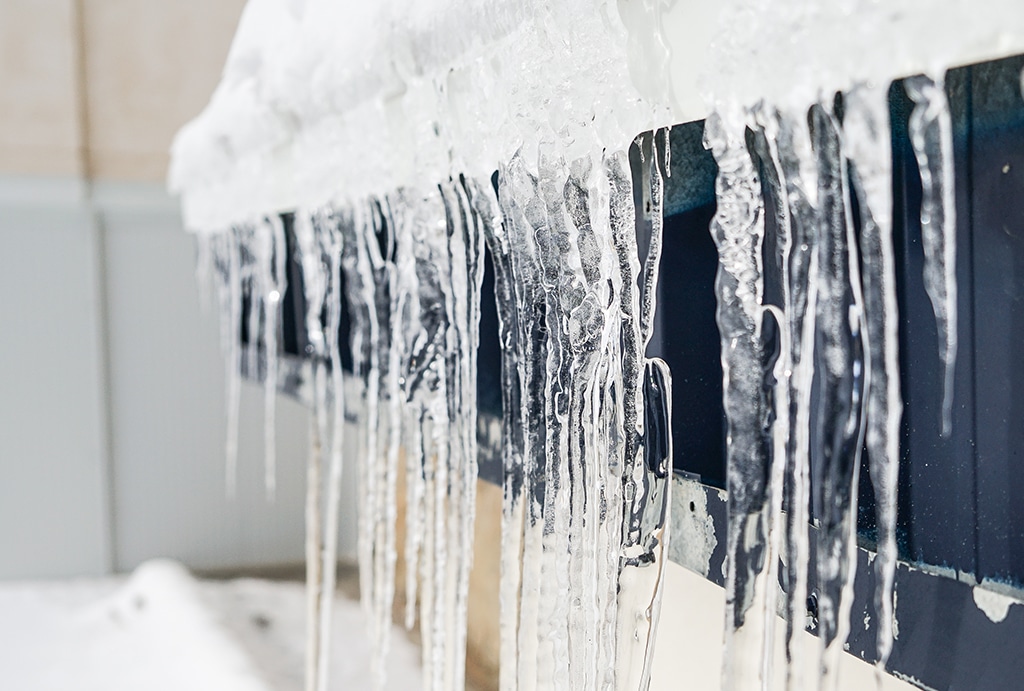There are many concerns home owners face in the winter months when it comes to taking care of their homes. For roofing issues the biggest challenge is dealing with the formation of ice dams. An ice dam is a hump of ice that accumulates on the roof along he edge of the eaves when certain winter time conditions are met. An ice dam can damage both your roof and the inside of your home and ice dam roof damage is among the most commonly reported insurance claims for homeowners in the winter. Ice dams can tear and gouge shingles and tiles and the accumulating ice and melting water can seep into the home and cause damage; they can also weaken the roof due to excessive weight from the ice and water. There are several things homeowners can do to help them avoid getting an ice dam or at the very least to reduce the risk of damage when one has already formed on the roof, but there’s really only one cure and effective way of dealing with ice dams: the use of better sealing, insulation, and venting for both the attic and roof area. Stay Dry Roofing has all the solutions you need to stay on top of your roofing maintenance during the winter.
Why do ice dams form?
An ice dam can form on the roof during snow falls and periods where there are fluctuating temperatures during the winter. They commonly form when the roof over the attic has been warmed to the point that the under layer of snow on the roof melts. The water trickles under the layer of snow and can seep down through the roof until it reaches the eave of the roof. This area is colder because it is not in contact with the rest of the home as much so the water refreezes in this area. As the water freezes, it forms into a dam of ice that continues to grow and mound as more melted water accumulates. The flatter the pitch of the roof, the easier it is for an ice dam to form and grow because it is easier for the water to accumulate. Dealing with ice dams is one of those things homeowners have to be ready for when they live in areas that get brutally cold winters.
How does an ice dam damage the roof?
When an ice dam is allowed to grow and is not kept in check it can get to the point where it is big enough to cause major problems with the roof. Melted water backs up behind the ice wall and since it has no where to go and the heat of the roof over the home stays warm, the water can then begin to seep underneath the shingles. Eventually, this water will drip into the roof structure and can lead to rot and mildew, it can drip into the insulation and cause problems in the ceiling and walls. If the ice gets too heavy the roof can collapse. And if chunks break off the roof they can fall and damage gutters, landscaping, cars, or hurt pets and people. Dealing with ice dams is a big obstacle for many home owners and preventing ice dam roof damage is the best way to cope during the cold weather.
Dealing with an ice dam that has formed
- Get rid of the ice dam gradually by breaking it apart into small chucks. Never use an ax or anything sharp or you will cut into the shingles. Instead, tap lightly with a blunt mallet. It is best to call in roofing experts to help with this because the roofs are slippery and you can still easily damage shingles and tiles.
- Clear out gutters and downspouts so they are not filling up and adding to the ice accumulation trouble. Again, this is hazardous work involving being on a ladder and and it can be difficult to clean and clear gutters without damaging metal or plastic that has become brittle due to the cold.
- Those with roofing expertise and enough experience and melt troughs through the ice dam with specially designed calcium chloride ice melter. Do NOT use rock salt because it can corrode gutters, stain and fade paint, damage tile and the salt water run off can ruin and kill grass and plants. Using a simple tube of cloth, fill it with calcium chloride, tie off the top, and lay it vertically across the ice dam. As it melts through the ice it will melt away part of the ice dam and make it easier to slide chucks off the roof.
At Stay Dry Roofing, we offer affordable practical solutions to repair damage to your roof that has been caused by ice damming and the associated water damage that can occur.
Preventing ice dams
The best way to go about dealing with ice dams is to work to prevent ice dam roof damage in the first place. There are several ways you can do this. You can scrape snow off the roof to keep it from accumulating and growing to the point that an ice dam can begin to form. This will require you to either stand on the ground or on a ladder and brush snow off or to climb onto the roof and push snow down to the ground. Both can be risky so it is best to call in roofing experts to do any snow removal for you this season.
Before the snows begin to fall you can spray your roofing surface with a water proofing spray that helps block melting ice water from seeping in and to also create a slick surface that ice and snow can slide off of easily.
The experts ice dam cure
All of these points discussed so far address the ice dam symptoms, but are not talking to the underlying problem, which is the warm roof that contacts the snow and causes snow melt and ice formation. At Stay Dry Roofing, we are leaders in dealing with a range of winter roof concerns, one of the most common being ice dams and the associated water damage that can occur. Roofing experts point out that they only known way to cure an ice dam and also to prevent one from forming at all is to:
- Seal any and all areas where warm air leaks into the roofing area from the living space below- this warmer air and get into the spaces immediately below the roof sheathing and will cause the melting of snow that leads to ice dam formation.
- Insulate the living space. This is important not just to conserve energy and keep the home at a comfortable temperature but it is also important to ensure the roofing area is insulated well enough to prevent conduction and convection of heat into the attic and roofing area.
- Vent the space between the insulation and the roof sheathing. This is a important step because it helps to ensure that any heat that does leak through into the attic and roof area is carried away rather than being allowed to build and warm up the roof and cause snow and ice melting.
Contact us
If you need help making sure your roof is ready for winter snow give us a call and discoverer the Stay Dry Roofing difference for yourself! We are proud to serve our community and the surrounding area and we stand by our commitment to quality and excellence. Prevention is key in keeping ice off your roof and water out of your home! While you can’t prevent the weather from changing and there is no way to keep 100 percent of the snow and ice off your roof, there are things you can do to keep it under control and to stay on top of routine removal to keep it from accumulating. This is why winter preparation work for your roof is such an important maintenance chore that homeowners cannot afford to skimp out on. Dealing with ice dams and the extensive ice dam roof damage that can come with it is a big deal so get the experts to help ypu protect your roof this winter. Call us today to set up your consultation before the first snows begin to fall!

